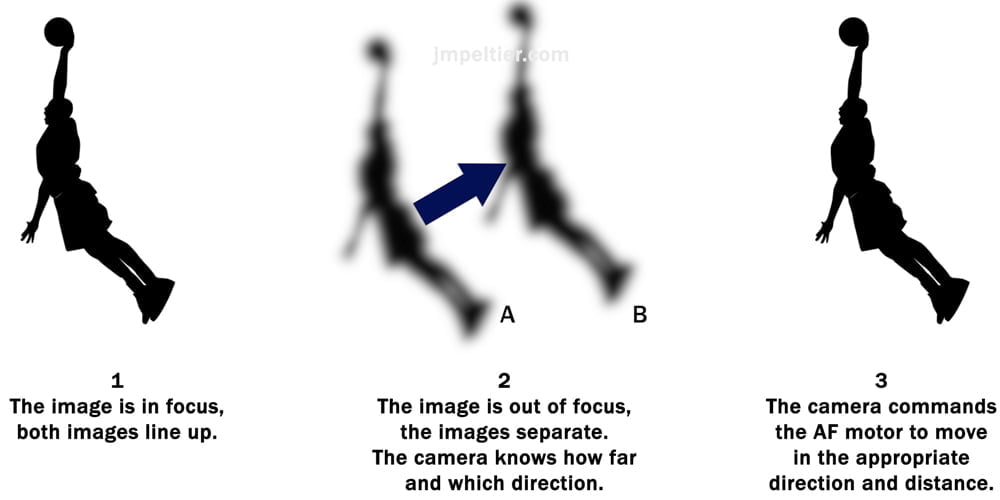Disclosure: This post may contain affiliate links. I earn a small commission of product sales to keep this website going.
You’ve seen the specs – here for the Sony a6500:
“169 contrast detection points and 425 phase detection points!” Well, that’s cool, but what is phase detection and contrast detection autofocus?
What is Contrast Detection autofocus?
Contrast detection is the simplest, most accurate method of autofocus technology. Thus it’s the cheapest autofocus technology.
The name should say it all: the camera looks at the contrast between edges and moves the focus motor until the contrast is the sharpest.
This is actually how our brain works when we use unaided manual focus – we look at edges and move the focus ring until the edge contrast is the hardest. Or what we call “sharp” in simple terms. We go back and forth with large adjustments first, then smaller refinements until we get there.
Let’s look at these cartoon flowers as an example of the steps involved in contrast detection as it zeroes in on the proper focus:

Contrast detection autofocus – despite being the easiest, cheapest, and most accurate method of focusing – is also the slowest.
If you’ve ever seen the autofocus motor “hunt” back and forth, kinda like you would do when manually focusing, this is contrast detection at work.
It’s comparing focus distances to find the maximum contrast point.
What is Phase Detection autofocus?
Okay ready to get really techie? No? We’ll try to keep this simple.
Imagine an image hitting a prism. The prism then splits that image into two parts.
If the image is in focus, the split images will line up. If not in focus, the images won’t line up.
This is exactly how the “split prism” manual focus aide works in the middle of the viewfinder on old SLR film cameras. You’d move the focus ring until the image lines up and voila, in focus. Very fast.
Much faster than trying to detect where the contrast edge is the sharpest.
When a digital camera says it has “425 phase detection points,” that means there are 425 places on the sensor where it can compare that split image.
Because the sensor knows which split image is which, it knows precisely in which direction and how much to move the focus motor to bring the split image together.
Since phase detection is awesome for moving subjects, let’s see how it works with a dunking basketball player:

DSLRs use an actual prism to split the image onto the focus sensor while mirrorless cameras do this directly on the sensor. The technology is more expensive and in a DSLR adds a little more weight.
Which is better: Contrast or Phase Detection autofocus?
The answer is, like everything else in photography, “it depends.”
For still subjects and high contrast scenes
Contrast detection autofocus will give you the most accurate focus when shooting single-shot autofocus with a still subject.
There are fewer chances of the camera focusing in front of or behind the subject as sometimes happens with phase detection.
This is called front focus or back focus, and you should still be aware of it with contrast detection.
But remember that the lens motor is moving more with contrast detection autofocus. This means that it’ll use more juice. The motor will also be moving a little slower with larger lenses with multiple glass elements.
For moving subjects
If your subject is moving phase detection autofocus will give you the fastest and most accurate autofocus.
You still have a risk of back or front focus, but with image tracking technology and multiple phase detection autofocus points, this is less of a factor.
You’ll be shooting in continuous or servo autofocus modes so the camera continually adjusts the focus as your subject moves.
This is what happens with front focus, for example. The phase detect points picked up an object closer to where I wanted to focus and focused on that instead. The green squares are what you would see on a Sony Alpha.
Be aware of the displayed focus points; if you see them in the wrong spot, you should change to a different focus area.

Contrast detection autofocus is not good with moving objects because of the time it takes to find the maximum contrast.
By the time that maximum contrast point is detected, the subject has already moved to a different distance, and the camera must find that position again.
Phase detection autofocus will immediately snap the motor to the proper focus point for continuous shooting.
In low light & low contrast
Just remember that both of these methods require light to focus.
If the image has no contrast or little light, the camera may not have enough data to use either focus method. There are ways around this.
- Some cameras will bump up the ISO when you hit the focus button. This amplifies the light to focus, then the ISO will drop to what you have set.
- Lights & autofocus assist beams. Cameras & flash units will emit beams of light in an attempt to illuminate your (near) subject. You can also use a high powered flashlight if your subject is further away.
- Use back-button focus so that your camera won’t try to autofocus every time you hit the shutter button, especially with still scenes.
What is Hybrid Autofocus?
You’ll see some cameras advertise Hybrid Autofocus.
The Sony a6500 is boasting the fastest autofocus in the world right now at 0.05 seconds using hybrid autofocus.
Hybrid autofocus generally starts with the quick phase-detection autofocus method.
It then uses contrast detection autofocus to refine the edge, and because phase detection brought it to near that point, contrast detection doesn’t take nearly as long as it usually would.
So, phase detection returns it to what our eyes would perceive as perfect focus, then takes it beyond that with contrast detection.
Now that you understand the differences between phase detection and contrast detection autofocus, I hope the understanding will improve your photography as well! Any questions or comments? Please leave them below!

Best Cameras for Graphic Designers (2020) | The Ultimate Guide
Wednesday 17th of June 2020
[…] The A6500 has a 4D autofocus system that works with 425 phase-detect autofocus points. […]
6 Best Cameras for Car Photography (2020) | DSLR, Mirrorless, Budget ...
Saturday 13th of June 2020
[…] Fast Hybrid AF System employs a combination of 693 phase-detection points and 425 contrast-detection […]
Olvida lo que escuchaste sobre el M50 de Canon - Producción de Videos
Wednesday 10th of June 2020
[…] de las mejores cosas de esta cámara, y no tenerla en 4K es un gran paso en falso. La cámara usa AF de detección de contraste para enfocar un sujeto al grabar video en 4K, que es una forma más antigua y lenta de enfocar el […]
Forget What You Heard About Canon’s M50 – STUDIONICS
Wednesday 10th of June 2020
[…] of the best things about this camera, and not having it in 4K is a huge misstep. The camera uses contrast-detection AF to focus on a subject when shooting video in 4K, which is an older and slower way to focus on the […]
Binh
Tuesday 21st of April 2020
Thank you John, Your explanation is clear and easy to understand
John Peltier
Wednesday 22nd of April 2020
Appreciate the feedback, thanks.